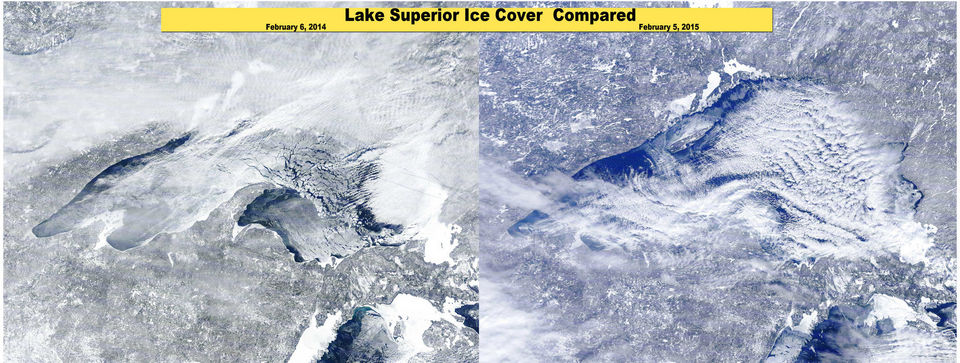Different Year Different Ice
Ice, ice baby. How much is there and is it safe?
Great Lakes ice cover: View from space shows difference from last winter
Follow on Twitter
on February 06, 2015 at 1:50 PM, updated February 06, 2015 at 8:23 PM
All of the Great Lakes combined now are covered 57.1 percent in ice. But this time last winter there was already 77.2 percent ice cover on the entire Great Lakes.
Lake Superior was 90.9 percent covered last year at this time versus 50.1 percent now.
Lake Michigan had 55.2 percent ice cover and now has 36.2 percent ice.
Lake Huron was 83 percent covered on Feb. 5, 2014 and now is 61.8 percent covered.
But Lake Erie and especially lake Ontario have some interesting points.
Lake Erie actually has more ice on it now than this time last year. It’s just by a small percent, but Erie is 94.5 percent covered now versus 93.2 percent last year.
Lake Ontario has quite a bit more ice so far this year. Right now Lake Ontario is covered 30.5 percent in ice, while last year it only had 24.9 percent ice at this time.
Another interesting point is Lake Ontario’s whole lake average water temperature. Currently all of Lake Ontario is .7 degrees F colder than last year.
Lake Superior’s surface water temperature is also surprisingly .7 degrees F colder than last year.
Otherwise the lake temperatures are very similar or just fractions of a degree warmer than last year.
Watch the ice build next two weeks
The Great Lakes ice should continue to grow rapidly. It looks like several waves of bitterly cold arctic air are poised to pounce on the Great Lakes Region over the next two weeks. We could have several days that drop below zero. Some data says we could have a few mornings of -10 to -20 degrees.
So more pretty images of growing ice will be on the way. We just have to hope for clear skies during the middle of the day to see the images. And getting totally clear skies over any Great Lake at this time of year is tough, thanks to lake effect clouds.

DNR NEWS – FOR IMMEDIATE RELEASE Feb. 9, 2015
Variable weather means ice may not be safe
With recent temperatures varying from below 0 to 40 degrees, the Minnesota Department of Natural Resources reminds winter recreationists that they should check local conditions before venturing onto the ice.
“A spell of cooler weather does not mean the ice on a lake, pond or river is safe,” said Stan Linnell, state boating law administrator. “Contact a bait shop and check to see if local ice conditions are thick enough to hold you and your fish house or vehicle and find out what areas to avoid.”
Varying temperatures have created areas of thin ice or open water that may later refreeze, especially in the southern half of the state. Refrozen areas don’t stand out on lakes lacking any snow cover.
Linnell offered these other safety tips:
Don’t drive on ice at night.
Don’t drive through channels or other areas with current.
Don’t drive past thin ice signs or over pressure ridges.
“Sadly, we have seen several incidents where ATV’s and cars have gone through the ice and people were injured, killed or remain missing,” Linnell said. “The bottom line is it‘s crucial that people do not let their guard down and recognize ice is never 100 percent safe.”
For more information, visit www.dnr.state.mn.us/safety/ice/thickness.html.

Leave a Reply
You must be logged in to post a comment.